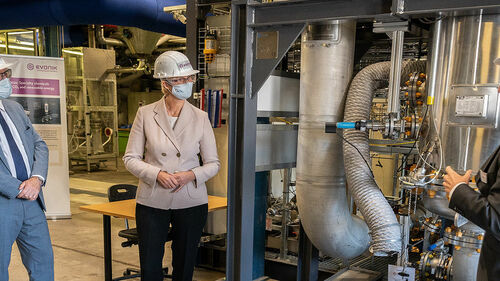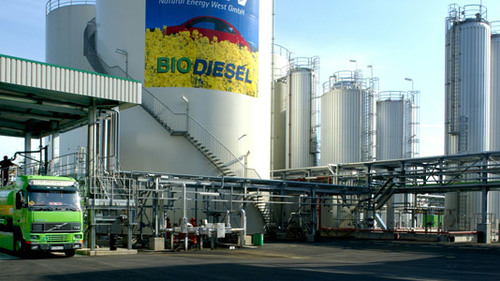Evonik and Siemens commissioned a pilot plant that uses carbon dioxide and water to produce chemicals at Marl, Germany
Marl, Germany. Evonik and Siemens Energy today commissioned a pilot plant sponsored by the German Federal Ministry of Education and Research (BMBF) that uses carbon dioxide and water to produce chemicals. The necessary energy is supplied by electricity from renewable sources. The pilot plant is located in Marl, in the northern Ruhr area, and its innovative technology of artificial photosynthesis should contribute to the success of the energy revolution. It is an essential part of the Rheticus I and II research projects, which are sponsored by the Federal Ministry of Education and Research (BMBF) with a total of 6.3 million euros.
German Federal Minister of Education and Research Anja Karliczek said on the opening ceremony in Marl, "I am delighted that we have today given the go-ahead for a new test facility of the very highest standard in Marl.With Rheticus, we are showing how we can set up climate-friendly production processes in the chemical industry and at the same time manufacture new innovative products. And this works not only here in Germany, but potentially all over the world. This opens promising opportunities for technology exports. We want to promote effective climate protection and continue to have a strong industrial base in Germany. I am firmly convinced that we can succeed in both. I am pleased that my ministry is now investing a total of 6.3 million euros in the new pilot plant in Marl with this goal in mind and wish all those involved every success.“
Stefan Kaufmann, Member of the German Bundestag and Federal Commissioner for Green Hydrogen, states, "Today's start of the Rheticus pilot plant for the production of specialty chemicals is a real pioneering achievement. After all, a green hydrogen economy can only succeed in Germany as a country of innovation, if innovative technologies are used. This requires courage and a spirit of research. The project partners at Rheticus are exemplary in demonstrating this."
Harald Schwager, Deputy Chairman of the Executive Board of Evonik and responsible for innovations, said, "Climate protection is not possible without chemistry, because our industry supplies and develops solutions for the energy turnaround. Research projects such as Rheticus are a motivation and innovation driver for a sustainable society". At the same time, he warned against speed when phasing out fossil fuels. "Security of supply and reliability in political decisions set the framework in which new things are created.”
Christian Bruch, CEO of Siemens Energy: "Our goal is to use innovative technologies to enable new, more sustainable solutions. With our hydrogen and CO electrolysis, we are building a bridge from green electricity to sustainable material applications. The close cooperation between politics, science and business partners, like Evonik, is an important step in this direction.“ The Rheticus research project is a spin-off of the Copernicus projects, one of the largest research initiatives of the German Federal Government on energy system transformation. Rheticus demonstrates how the Power-to-X idea can be successfully put into practice.
For the idea of artificial photosynthesis, which is behind the Rheticus experimental facility, the researchers took nature as a model. Just as plants use solar energy to produce sugar, for example, from carbon dioxide (CO2) and water in several steps, artificial photosynthesis uses renewable energies to produce valuable chemicals from CO2 and water through electrolysis with the help of bacteria. This type of artificial photosynthesis can serve as an energy store and thus help to close the carbon cycle and reduce carbon dioxide pollution in the atmosphere.
The pilot plant has started up in Marl, the largest Evonik site. It consists of a CO electrolyzer, developed by Siemens Energy, a water electrolyzer and the bioreactor with Evonik's know-how. In the electrolyzers, carbon dioxide and water are converted into carbon monoxide (CO) and hydrogen (H2) with electricity in a first step. This synthesis gas is used by special microorganisms to produce specialty chemicals, initially for research purposes. These are starting materials for special plastics or food supplements, for example.
In the coming weeks, the composition of the synthesis gas and the interaction between electrolysis and fermentation will be optimized. In addition, a unit for processing the liquid from the bioreactor will be set up to obtain the pure chemicals.
After successful completion of the current Rheticus project phase (Rheticus II), Evonik and Siemens Energy will have a unique platform technology at their disposal that can produce energy-rich and valuable substances such as specialty chemicals or artificial fuels from CO2 - in a modular and flexible manner.
information on bmbf activities in the field of "power-to-x"
In 2019, the BMBF has provided more than 500 million euros to support energy research. Power-to-x technologies are a central area of BMBF activities in energy research. The core element here is the BMBF Kopernikus project "P2X", from which the "Rheticus" project was also spun off. The "P2X" project investigates the production and transport of green hydrogen (power-to-gas) and the use of hydrogen in filling stations, heating stoves (power-to-heat), chemicals (power-to-chem) and plastics production (power-to-plastics). P2X" is also working on the production of synthetic and climate-friendly fuels using synthesis gas (power-to-liquid). In doing so, P2X specifically uses CO2 as a raw material in its value-added chains. In addition, the "Carbon2Chem" project is developing processes for using the climate-damaging exhaust gases produced during steel production as a raw material. Finally, precursors for fertilizers, plastics and fuel are to be produced as products. Because this requires additional hydrogen, the project consortium operates an electrolyzer. These are just two examples of BMBF funding for Power-to-X technologies.
Categories
Investments
Countries
Companies
Latest news
INEOS launches €250m investment supported by the French Government to secure the future of French industry at Lavera
The project marks the first phase of a long-term regeneration plan to reduce emissions, boost reliability, efficiency and competitiveness, with support of the French State.
Hycamite’s technology to decarbonize shipping awarded AiP by industry leader DNV
Kokkola Industrial Park →Hycamite’s proprietary Thermo-Catalytic Decomposition (TCD) technology offers a new approach to producing clean hydrogen by breaking down methane, the primary component of liquefied natural gas (LN...
Clariant catalysts will power the Ecoplanta: Europe's first waste-to-methanol plant
Chemmed Cluster Tarragona →Repsol is building Europe’s first plant to produce renewable methanol from urban waste The facility will use Enerkem gasification technology to produce 240 KTA of methanol Clariant will supply cata...
Lilly plans to build a new $3 billion facility to boost oral medicine manufacturing capacity in Europe for patients worldwide
Netherlands site will bring 500 manufacturing and 1,500 construction jobs while further strengthening Lilly's global supply chain


